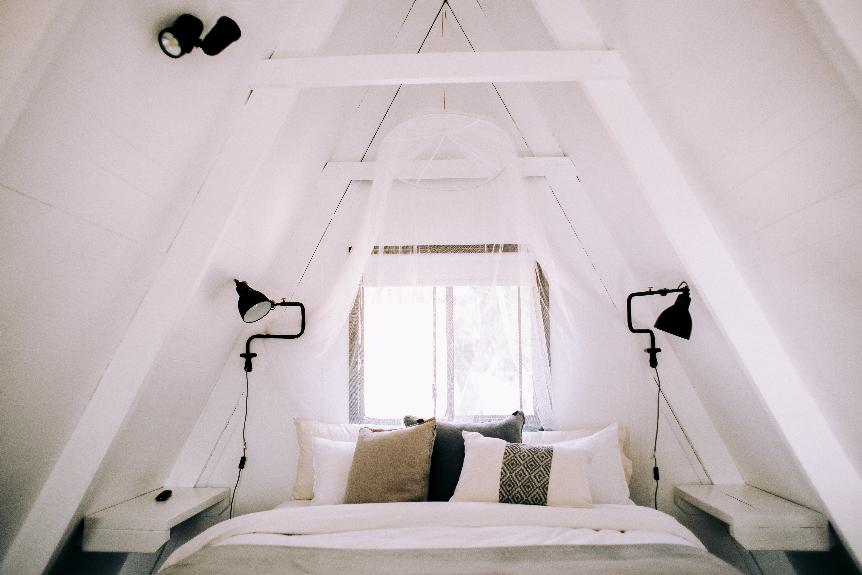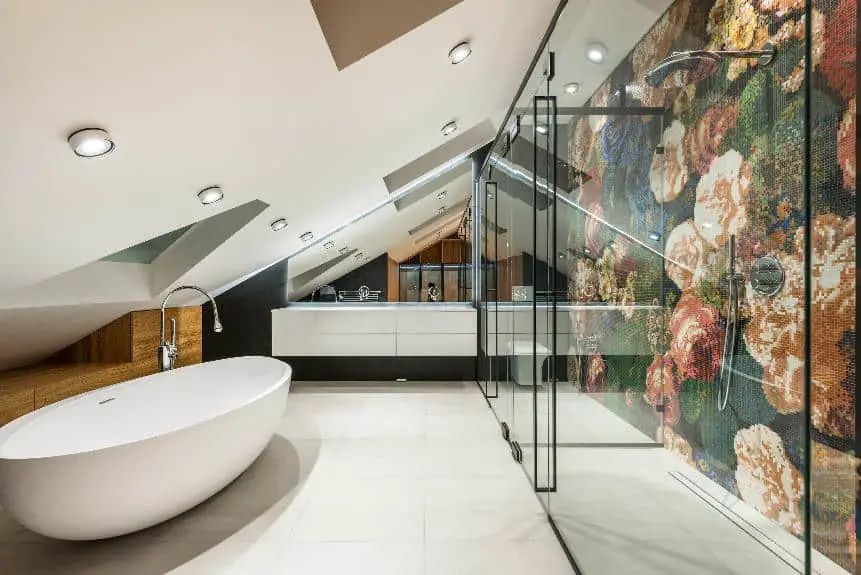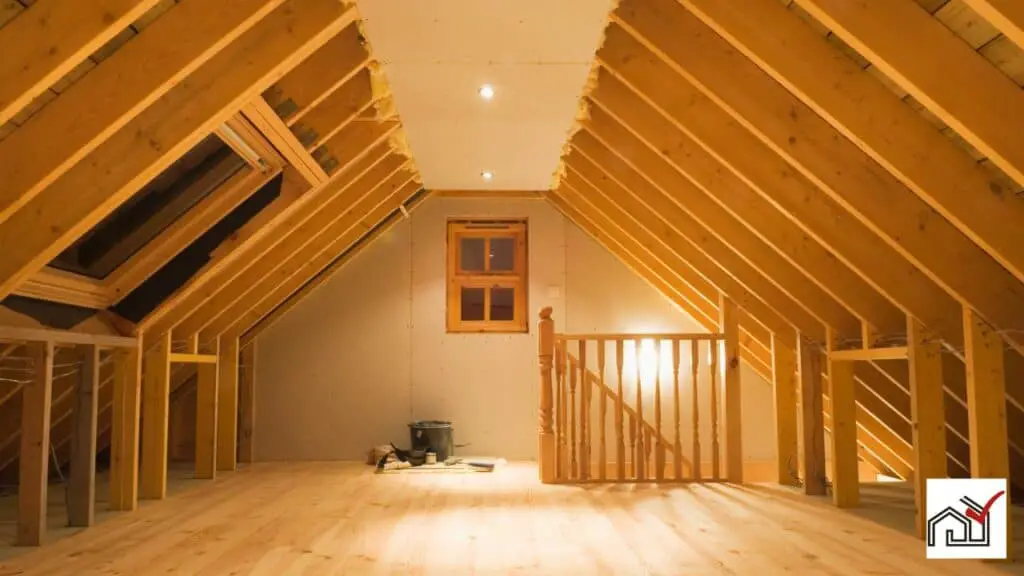To hide an attic door in a wall, start by evaluating the entry and choose materials that match the room's design.
Build a frame that fits flush with the wall and finish it with paint and decorations that match the surrounding area.
Ensure that the door remains easily accessible and safe to use.
Assessing Your Attic Entry
Before hiding your attic entry, inspect it carefully to understand its design and structure. This ensures that your concealment methods will work well with your specific type of attic access.
Attic access types differ. Some homes have a basic ceiling panel, while others have a scuttle with a drop-down door and ladder. Recognize your attic's entry type before choosing concealment methods.
For an attic scuttle with a ladder, choose concealment options that don't interfere with the door or ladder use. Consider how often you use the attic, as frequent use might require easy-to-use concealment solutions.
Check the area around the attic door to see how you can make it blend in with your home's decor. Proper understanding of the attic entry will help you choose concealment that is both effective and visually pleasing.
Selecting the Right Materials
Selecting appropriate materials is essential for disguising your attic door and keeping the room's look consistent. Choose materials that match the surrounding wall or ceiling to create a uniform appearance. Use the same texture and paint as the existing ceiling for ceiling-mounted doors. For a wall-mounted door, match the wall's finish with paint, wallpaper, or paneling to make the door blend in when closed.
Consider adding elements like a color-coordinated pull cord or a decorative light box to distract from the attic door while enhancing the room's decor. Options like custom artwork or a mirrored door can also merge the access point with your home's design, turning a practical element into a decorative feature.
Consult with interior designers or contractors to select high-quality materials that fulfill your design and practical requirements. They can offer advice on the latest materials and trends that are safe and suitable for hiding an attic door. The correct materials will camouflage the door and ensure safe and functional attic access.
Designing a Disguised Door
Selecting appropriate materials is essential when creating an attic door that aesthetically matches the surrounding wall. The design should account for the visual context of the space where the door will be located. The use of decorative elements can redirect attention from the door, allowing it to blend with the home's decor.
To conceal the attic door, consider using pull cords that match the door's color for a discreet access point. These cords can be connected to ladders that are either fixed or retractable, facilitating access while preserving the appearance of a continuous wall or ceiling.
Another option to disguise the attic door is the installation of decorative light boxes, which serve the dual purpose of masking the door and providing ambient lighting. Alternatively, creating a mural that incorporates the door into the design can offer a visually engaging solution.
For a more geometric approach, constructing a matching grid or framework can render the attic door less conspicuous. Using lumber to create a grid that echoes the door's size is a common technique to hide the door effectively.
Implementing these strategies requires meticulous planning and precision to maintain the attic's accessibility and achieve a hidden door that integrates well with the home's interior.
Constructing the Hidden Frame
To construct a hidden frame for an attic door, measure the door opening and the panel accurately. It is essential for the frame to be secure and blend in with the surroundings. The frame is the foundation for concealing the door and must be made with care to ensure it matches the room's design.
Choose a material for the frame that can support the panel's weight and matches the wall's texture and color. This will keep the door hidden when not in use. Firmly attach the frame to the wall with strong hinges for easy opening and closing.
For better concealment, consider installing a false ceiling with metal tracks and studs to attach ceiling panels. This creates a continuous look, hiding the attic entrance.
Finishing With Seamless Paint
After building a concealed frame for the attic door, paint it with a color and finish that matches the surrounding wall to keep it hidden when closed. Accurate color matching is essential for camouflage. Prepare the door and wall by cleaning them to create a smooth surface for painting. If there is trim, paint it the same color to ensure consistency.
For a consistent finish, use quality paint. A primer may be necessary to cover old colors or stains and provide a neutral base. Pay close attention to the edges where the door meets the wall, painting them carefully to prevent visible lines.
After the paint dries, inspect the door under different lighting and from various angles to confirm the seamless appearance. Correct any flaws to keep the illusion of an uninterrupted wall. A meticulous approach to painting will effectively conceal the attic door.
Adding Decorative Elements
Place artwork and shelves near the attic door to blend it with the room's decor and conceal it. These elements should appear as part of the room's aesthetic while also serving to hide the door. Arrange them so the door is less noticeable.
Install a light box near the attic door as a decorative element that also provides ambient light and helps distract from the door. This is particularly useful in older homes with prominent attic access.
Ensure decorative items do not block the attic door. Use lightweight art or wall hangings for easy movement. If using shelves, make sure items are quickly removable or use a swinging shelf. Light fixtures must be securely installed but should not impede attic access.
Consider painting a ceiling mural that includes the attic door for a bold decor choice, turning the door into an engaging part of the room's visual story.
Implementing Safety Measures
Safety must be the top priority when concealing an attic door to ensure it remains accessible and meets emergency exit requirements. While appearance matters, it should not compromise the attic door's functionality and safety. All decorative measures must adhere to local building codes that set standards for a safe attic entrance.
Ensure the attic door is easily accessible in emergencies, with a covering that does not hinder its operation. A sturdy and reliable folding ladder should be considered for safer and more convenient attic access.
Before hiding your attic door, measure its dimensions and the attic opening. Coverings, like a large mirror, need secure attachment to prevent accidents. Include security features in your design for both preventing unauthorized entry and allowing quick evacuation.
Seek professional advice from contractors and interior designers for creative and safe solutions. Their expertise ensures the concealed attic door is safe, compliant, and aesthetically pleasing.





